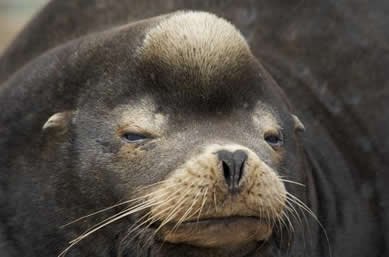

AN INTRODUCTION TO THE PINNIPEDS (FIN-FOOTED MAMMALS) OF BRITISH COLUMBIA
(Seals and Sea lions)

California Sea Lion (Zalophus californianus), photo by Peter Llewellyn.
by
Peter F. Olesiuk and Michael A. Bigg
Seals and sea lions, also known as pinnipeds, are a familiar sight in coastal waters off British Columbia. These mammals lead partly a terrestrial and partly a marine existence. Their streamlined bodies, specialized flippers and insulating layer of blubber allow them to travel and forage at sea with ease. However, unlike dolphins, porpoises and whales, pinnipeds require land to bear and suckle their young and to rest.
The waters off B.C. are home to five species of pinnipeds representing two families. These are the Phocidae, or true seals, which includes the northern elephant seal and harbour seal, and the Otariidae or eared seals, which includes the northern fur seal and the Steller and California sea lions.
The true seals are characterized by the absence of external ear flaps and by their short, fur-covered flippers. On land they cannot easily raise their head and shoulders and thus tend to remain prostrate. The rear flippers cannot be rotated forward, so while on land they move in a caterpillar-like fashion, rhythmically undulating their bodies with synchronized dragging strokes of the front flippers. In water, they swim by alternating side-to-side strokes of their rear flippers, while the front flippers aid in steering.
Members of the Otariidae, on the other hand, have small external ear flaps and large hairless flippers. On land the front flippers are used for body support to raise the head and shoulders. The rear flippers can be rotated under the body, which allows these animals to amble over land using both the front and rear flippers. While swimming, they use their front flippers like wings to propel and steer themselves.
Seals and sea lions in B.C. have evoked a great deal of interest over the years. At one time, they were utilized extensively for food and clothing by coastal natives. Between the early 1900s and late 1960s, they were hunted commercially and their populations regulated by predator control programs. However, increasing public sympathy toward marine mammals prompted changes in management and in 1970, harbour seals, northern elephant seals, and Steller and California sea lions were protected under the federal Fisheries Act. The northern fur seal has been protected since the early 1900s under the terms of the Interim Convention on Conservation of North Pacific Fur Seals, an international agreement involving Canada, Japan, the Soviet Union and the United States.
Since 1970, several species have become more abundant off our coast, causing concern among fishermen, who often view these animals as competitors for fish and as a source of damage to their gear and catch. It is not surprising, therefore, that many fishermen support culling programs that would maintain populations at low levels. However, this solution conflicts with the goals of many others, who believe populations should be left to reach a natural balance. Resolution of these differing perspectives presents a dilemma for fisheries managers in B.C., and in many other parts of the world.
Extracted with permission from the original brochure: Olesiuk, P.F. and M.A. Bigg. 1988. Seals and sea lions on the British Columbia Coast. DFO Special Publication, Pacific Biological Station, Nanaimo, B.C
Please cite these pages as:
Author, date, page title. In: Klinkenberg, Brian. (Editor) 2023. E-Fauna BC: Electronic Atlas of the Fauna of British Columbia [www.efauna.bc.ca]. Department of Geography, University of British Columbia, Vancouver. [Date Accessed]
© Copyright 2023 E-Fauna BC.